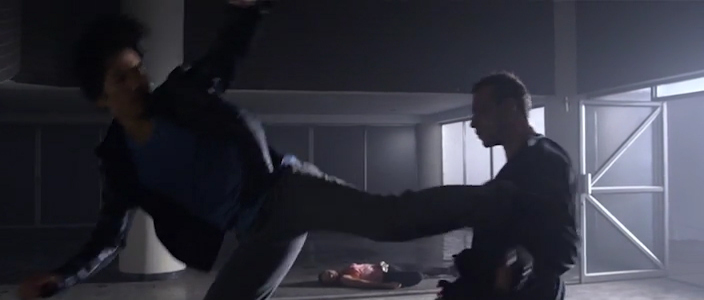
In a couple fights, Kazuya “steps” up onto his opponent to kick them multiple times; however, it literally looks like he’s stepping up and pushing off instead of trying to cave their ribs in.
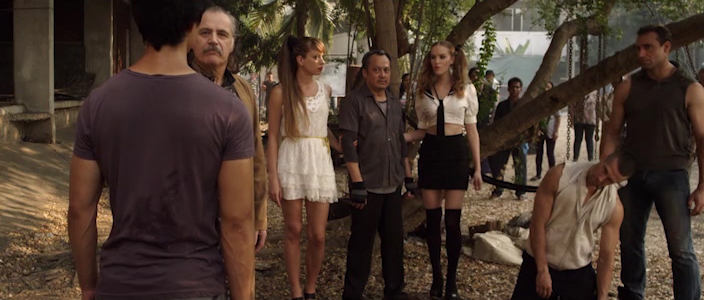
The Minister makes Kazuya fight, but Kazuya refuses to kill his opponent (the man on his knees). So, the Minister tells him he can instead kill the janitor (the man between the two women) because he knows they’ve started to form a friendship, and he can use that to make Kazuya finish the other guy.
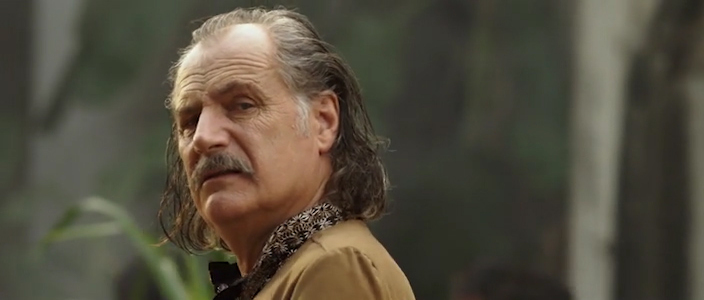
This is the shot where The Minister spots Kazuya talking with the janitor, and it looks like he’s caught them plotting a rebellion. If he’s realizing that he can use the innocent, friendly janitor as leverage against Kazuya, shouldn’t he be smiling menacingly?

No, Kazuya does not appear conspicuous at all, paying absolutely no attention to the half-naked girls dancing on tables while stalking his target like the frickin’ Terminator.
Review by Jay Wilson There’s a great metaphor for Tekken 2: Kazyua’s Revenge in the classic Daniel Keyes novel, Flowers for Algernon, where a mentally handicapped man undergoes a treatment to increase his intellect. The author tells his tale through a series of journal entries by its main character, Charlie Gordon, and we, the reader, can see the progress reflected in Charlie’s ever-growing vocabulary and mastery over the English language, but it’s not without its hiccups. When Charlie first learns about punctuation, he mistakenly believes he can insert periods, commas, exclamation points, and question marks anywhere and everywhere, and needless to say, that entry is a barely-comprehensible mess. That journal entry is Tekken 2. To start off, Kazuya’s Revenge contains way too much slow motion. Slow motion is used for emphasis—perhaps a character enters a surreal, dreamlike situation; maybe they’re reaching a profound revelation; maybe it’s just to enhance the big climactic moment at the end. Slow motion means “This is special.” But if everything is in slow motion—if everything is special—then nothing is special. Every single time anyone enters or leaves Kazuya’s apartment building, it’s in slow motion. Every time his love interest appears, at some point she’s shown in slow motion, often doing mundane things under mundane circumstances. Sure, love at first sight or seeing said love interest descend some stairs all dressed up for the prom are staple slow motion moments, but this lady gets the slow motion treatment for buying groceries. And to make matters worse, Tekken 2 is an amnesia story where the main character slowly regains his memories with slow motion flashbacks while he walks from point A to point B (also in slow motion.) On top of that, it’s the same abstract, over-exposed imagery that starts out extremely brief and disjointed and gets longer and slightly less disjointed as the film provides more and more context; however, it never gets more interesting because we know the protagonist is Kazuya Mishima. It’s in the title. And even if it weren’t, it's frickin’ Tekken . Who else would he be? The intrigue behind an amnesia story is that a fact by itself doesn’t mean anything because it lacks context; therefor, every clue opens up an equal number of good and bad possibilities. This also allows the narrative to mislead the audience without actually misleading them. For example, let’s say the amnesiac discovers that he killed a hundred people. That sounds horrific, and the audience will automatically make that judgment. But suppose later on the amnesiac discovers he killed a hundred evil people to save a city from nuclear annihilation; it’s not so horrific anymore. The story naturally presented a fact and let the audience mislead themselves because they didn’t have all the facts. In Kazuya’s Revenge, by contrast, everything feels like a waste of time because we know who this guy is. And if you know anything about the Mishima family, you know how he lost his memories, why he lost his memories, and also who did this to him—you know all the facts. Furthermore, right out of the gate, Tekken 2 fails at even basic scene construction and editing. Kazuya wakes up in a hotel room, not knowing who he is or how he got there. Naturally he wanders around the room, splashes water on his face, and gets dressed. And while Kazuya does pause to study his shirt as it lay draped across the chair, once he puts it on, he doesn’t give it any more thought. We don’t get confirmation on his face that, “Yeah, this feels right.” Hypothetically, someone could have stuck him in that room with a shirt way too small or way too big, so it makes sense to have a silent moment where he considers: “it fits, so this must be mine.” More egregious, though, he puts on a jacket without ever checking the pockets. Even if the pockets feel empty, a person will still check for a receipt, an ID, cash, or anything they can find. Kazuya does not. He does, however, slowly turn and stare at the door and then slowly approaches it. We, the audience, know armed guards race up the stairs to apprehend him, but he doesn’t know that. The scene doesn’t give him any reason to know. The filmmakers could have made one of the guards stumble, maybe the step creaked, maybe a bystander gasped seeing these men come out of nowhere—something—and Kazuya could hear it. That would give context to Kazuya’s slow, cautious walk to the door. Even just adding a closeup of the unfastened door chain would elevate his caveman stare to an eagle-eyed observation that something was wrong. In the finished film, it just looks like he doesn’t know what a door is. 
In the most hilarious failure, they never actually show how Kazuya kills this guy in the strip club; they just show him entering the booth (previous screen) and then cut to this shot of the victim’s jiggling face which is supposed to imply strangulation but, given the setting, looks more like fellatio.
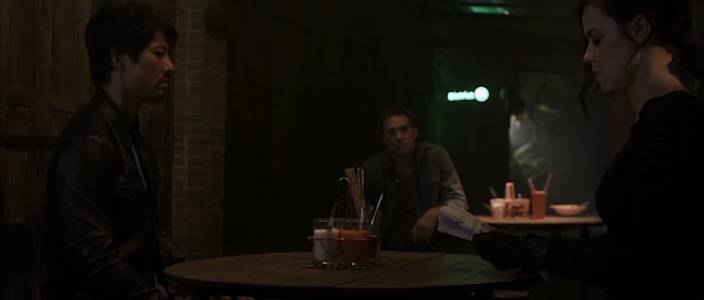
Rhona (right) has personally witnessed the Minister blow up a human being, threaten an innocent janitor, execute a fighter, and offer to murder children if the price is right. If that’s not enough to convince her that the Minister is a bastard, then I kind of doubt that the newspaper is going to do anything.
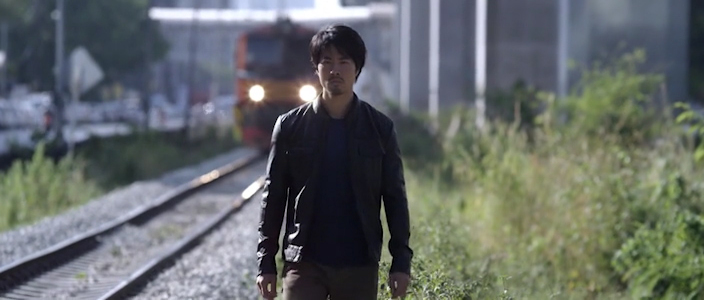
I cannot find any information on this production, but I bet they went with the amnesia plotline because it’s cheap to pad the run time with people wandering around aimlessly, especially if they overcrank the camera to show said wandering in slow motion.
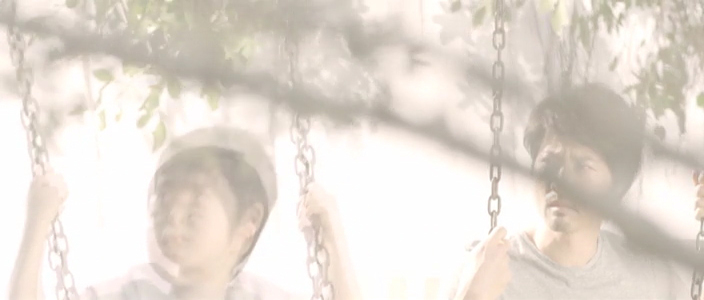
And, of course, an amnesia plotline also allows you to pad the run time with the exact same footage over and over and over again.
In true martial arts style, Kazuya beats up the men coming after him, escapes to the roof, and makes his way down to the street below where a red car immediately runs him over, and I couldn’t help but laugh because it’s a medium shot, and the vehicle comes into frame exactly like a Looney Tunes cartoon where Yosemite Sam escapes getting smacked by a pie only to get plastered by a truck. Literally the first glimpse the viewer gets of the car is the moment it plows into Kazuya. You know what would have made this an action scene? Showing exactly one shot of the car before it hit Kazuya. Put the engine revving up over that, show Kazuya’s reaction, and then show the car ramming into him (i.e., pay lip service to setup so the car doesn’t just magically appear; oh, and picking any other angle besides a side view would help too.) The driver gets out, wearing heels in the classic “it’s a woman” reveal which is presumably why they didn’t want to risk showing the car until the last possible second. She kicks Kazuya in the face and knocks him out. But before we move on, let’s rewind and talk about why the writing of the previous scene makes even less sense as the film progresses. Eventually the audience not familiar with Tekken will learn that the guards belong to Heihachi Mishima, Kazuya’s father, and that the senior Mishima is also responsible for Kazuya’s amnesia, which means Heihachi already had his son subdued and in captivity. So why did he dump Kazuya in a hotel room and then send his guards to collect him again? You might think Kazuya woke up during the brainwashing, killed the scientists, and escaped; however, the movie doesn’t actually show anything like that. The closest it comes is a hotel clerk recognizing him on sight and remembering he paid cash, which begs the question of how he, a prisoner fresh out of captivity, had cash on him. And this is just the first five minutes; the writing gets so much worse. Kazuya wakes up in a dirty slum, and we get introduced to “The Minister” who informs Kazuya that he will perform assassinations for him or else. You might think the Minister rescued Kazuya from his father, but Heihachi shows up with a henchman and watches one of Kazuya’s training sessions, which implies that The Minister is an underling. If that’s the case, why didn’t Heihachi just give his son to The Minister? If they don’t have a business relationship, why doesn’t Heihachi send his private military to retrieve Kazuya? Later on, Bryan Fury makes an appearance, and I genuinely thought he and Heihachi’s henchman were one in the same because they have similar faces, hair, builds, and wear similar clothes plus this Bryan Fury looks/acts nothing like his game counterpart plus I wrongly assumed the final showdown would involve game characters. Granted, the henchman acts like a brainwashed minion, and Fury has an actual personality; however, when the movie consistently and demonstrably leaves out key information and make no sense, you start automatically chalking up contradictions to filmmaker incompetence. I mean, Kazuya has a handler named Rhona Anders who serves as no name Nina Williams. At one point The Minister tasks her and Kazuya with assassinating Bryan Fury. The problem is if it weren’t for the bomb in Kazuya’s chest (placed there by The Minister), this would actually feel like a setup to kill Kazuya. Up until this point, Rhona has sat on the sideline and chilled while Kazuya did all the work. Now suddenly she has a sniper rifle with line of sight to one street—two at most—while Kazuya actively walks around searching for their target who could render the rifle completely useless by turning pretty much any corner. Tell me, what makes more sense? Using a long-range, high-powered rifle to eliminate a person you have to locate in a city with lots of cover, or sending an extremely dangerous man on a false errand out in the open so you can shoot him from 200 yards away in complete safety? But let’s move on and talk about continuity. I normally wouldn’t mention this in an action martial arts movie, but at one point Kasuya cleans a knife wound he received defending his neighbor, and he gives no reaction: he doesn’t tense up, he doesn’t clench his teeth, and his expression never changes. Later on Laura, said neighbor and love interest, stitches up the wound, and the pain still doesn’t make him wince. However, further on down the road, she surgically removes the bomb, and all of a sudden Kazuya feels pain—gritting his teeth, face twitching, and he even cries out. Now realistically, even normal people do not feel pain in a fight with adrenaline pumping, and they often do not realize they’ve been stabbed. However, Kazuya cleaned his wound much later, and the nurse stitched him up over twenty-four hours after that. The adrenaline excuse doesn’t work hours, much less days, later. 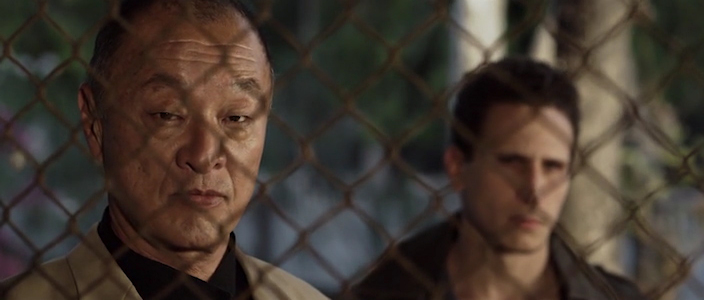
When your movie can’t even remember that pain hurts, then the viewers tend to assume all inconsistencies are filmmaker screwups and not their own misinterpretations. Also, making a no-name henchman more like Bryan Fury than the character that’s actually supposed to be Bryan Fury doesn't help.
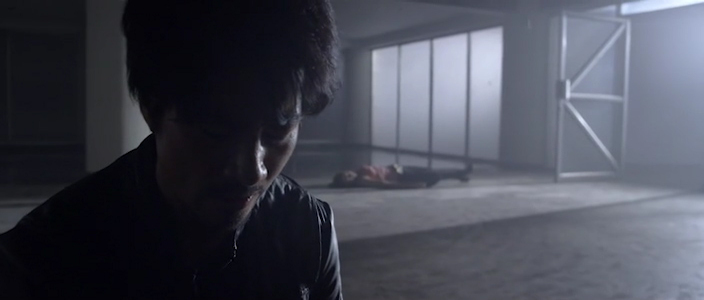
As hard as I am on Tekken 2, it does have its moments (albeit, they’re exceedingly few and far between, and you have to appreciate the individual components in isolation.) For example, I really like this shot of an exhausted, post-fight Kazuya despairing over the loss of his love interest who lies dead in the background.
I bring this up because even the most unqualified, untrained filmmakers—not just the actors, but everyone on set—should know the character with an open knife wound needs to act out pain in that scene. Everyone has hurt themselves. Everyone has personal experience to draw upon to express that hurt. But Tekken 2 and its entire crew gives us nothing. Now, if this movie can’t get the obvious right, how do you think it fairs with subtlety and nuance? How do you think Kazuya handles gazing at the woman he’s developing feelings for? The answer is he stares at her like she’s mighty Cthulu rising out of the ocean to devour the world, and the scene somehow gets weirder because this is where they film her in slow motion, laughing joyously while handling produce. I suspect the filmmakers made Kazuya’s Revenge at breakneck speed with no money because it screws up even basic things like automatic dialog replacement (ADR), which is the process where lines are re-recorded in post-production because there’s construction nearby, some jackass keeps honking his horn, or maybe the sound equipment just dies for no reason. ADR is supposed to be seamless; however, here dialog seems to have room echo even outdoors. More glaringly, though, not much actually happens, even less gets resolved, and none of it satisfies almost like they had to compromise each and every day because they needed, say, three hours to do a scene correctly but only had thirty minutes to actually work with. The Minister dies when Rhona nonchalantly strolls up and just stabs in him the back. A villainess dies because Rhona glances off to the side and promptly stabs her when she turns to look; Rhona talks to another villainess, grabs her throat, and you never see that villainess again. Laura shows up by Heihachi’s side, and we never learn if she was brainwashed or just bad all along because she kisses Heihachi and dies. And Kazuya doesn’t even get his revenge because Heihachi teleports across the room and leaves. Now, my opening paragraph compares Tekken 2 to the work of a mentally handicapped man. Am I implying the filmmakers are comparable to Charlie Gordon? No. You don’t have to be retarded to make something retarded. It’s like the old saying goes, “Good, fast, cheap—pick two.” Given that nobody’s heard of this movie, well, it’s safe to say “good” was never on the table. | ||||||||||||||||||||

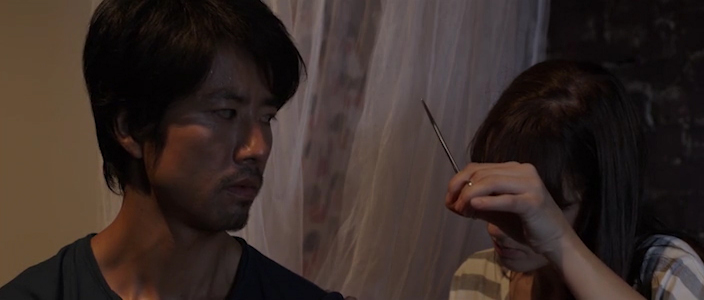
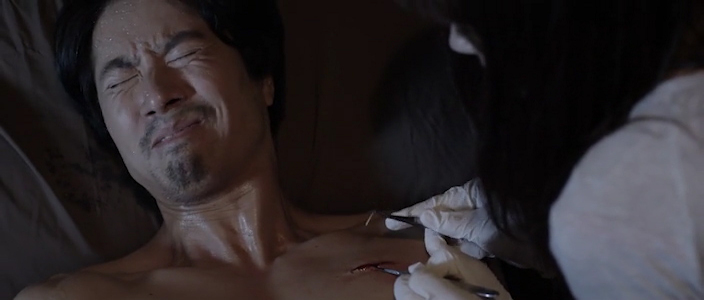
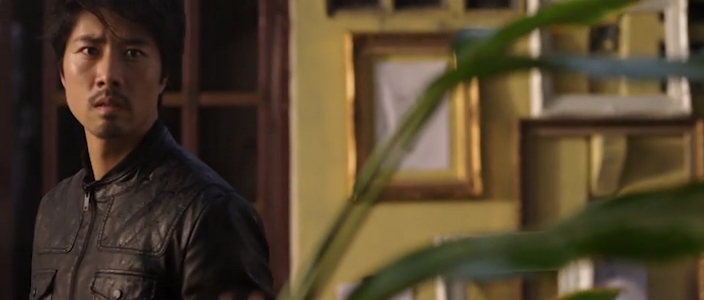
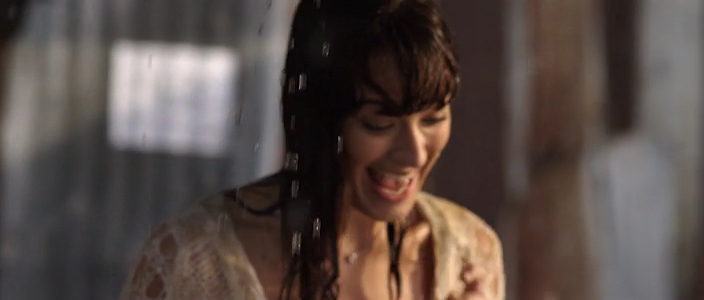 
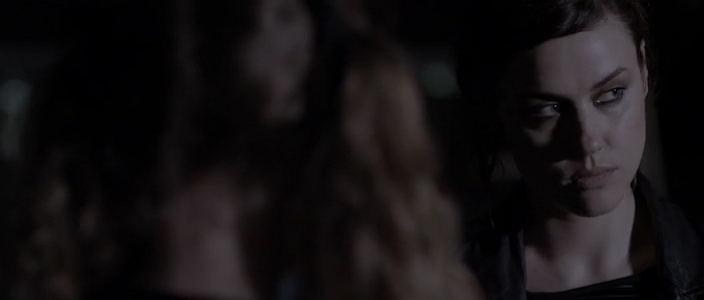

| ||||||||||||||||||||
|
| ||||||||||||||||||||
